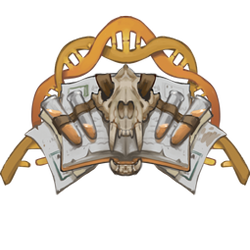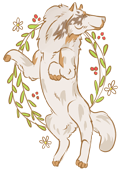Tokopedia
Go to Search
Breeding - Marking Genetics
Genetics | Markings | Affecting Pass Rates | Adding & Removing Markings
➥ Back to the main Breeding Guide
Example Geno: ee/Aa/tt/MM/nPb
All genes for markings are assigned a rarity, which determines how frequently they pass in breedings. This pass rate is increased if the gene is present on both parents, and/or if a dominant gene is present for the marking.
Pass rates of markings can be both increased and decreased by the use of certain traits and consumables in a breeding.
Aippaq’s Fortune, for example, increases the pass rate of non-dominant genes by 10%.
Borga’s Blessing reduces the pass rate for all Extremely Common and Common markings by 10%.
These adjustments to the pass rate are calculated after the chances based on the parents are determined. As such, using an item that reduces the pass rate of Marked on two nM x nM parents, can reintroduce the chance for a gene to not pass.
PotA tokens allow for markings to be both added and removed from unuploaded pups. One (1) token can add or remove a non-dominant copy of the marking. To remove or add a dominant marking to a pup, two (2) PotA tokens are required.
Multiple PotA tokens can be used on a single pup, however you must spend one (1) per change to the markings.
There are some limitations to these tokens however. They can only add or remove markings based on what was possible in the litter. They cannot add a marking that is not present on at least one of the parents.
Additionally, you cannot add a dominant marking if it was not possible between the two parents. Such as if one parent has blanket, the other does not, tokens cannot be spent to add the dominant blanket gene.
More details can be found on the Passage of the Alpha journal.
How Genes Work
- In genetics, letters are used to describe the genes that an animal has.
- In a tokota geno like the example above, slashes (/) are used to separate different genes.
- The first 3 genes (E, A, and T) are used to determine the ‘base’ or coat color of the tokota.
- Any genes listed after the base coat genes show which markings the tokota has. In this example, the tokota has Marked (MM) and Piebald (nPb)
Alleles
- Each individual gene has two halves or ‘copies’, also known as ‘alleles’.
- For example, for the gene ‘MM’, each ‘M’ is one allele.
- As another example, for the gene ‘nPb’, one allele is ‘n’ and the other allele is ‘Pb’.
- How the alleles are arranged determines whether that tokota is able to show that marking, and if that marking is heterozygous or homozygous (also known as a dominant gene).
- In a geno, a lowercase ‘n’ is used to show a ‘null’ allele. This means that this ‘half’ of the gene will not give the tokota a marking. The tokota can still display that marking if the other allele in the gene is not also a null allele.
- Examples
- ‘nn’ - This means that the gene did not pass and does not show.
- ‘nN’ - This means that the gene passed. The tokota is heterozygous for this marking.
- ‘NN’ - This means that the gene passed. The tokota is homozygous for this marking.
- Whether a tokota is heterozygous or homozygous for a given gene, it will always display that gene. The only important difference is that a tokota with a homozygous gene will more easily pass down a marking to its offspring than a tokota with a heterozygous gene.
- Note: There are no ‘recessive’ genes in tokotas. One allele of a gene is always sufficient for the tokota to display that marking.
Markings
All genes for markings are assigned a rarity, which determines how frequently they pass in breedings. This pass rate is increased if the gene is present on both parents, and/or if a dominant gene is present for the marking.
Extremely Common Markings:
Accents, Collared, Marked
| Marking Does Not Pass (nn) |
Marking Passes (nN) |
Dominant Marking Passes (NN) |
|
|---|---|---|---|
| nN x nn | 25% | 75% | 0% |
| nN x nN | 0% | 50% | 50% |
| NN x nN | 0% | 25% | 75% |
| NN x nn | 15% | 85% | 0% |
| NN x NN | 0% | 0% | 100% |
Common Markings:
Bearmarks, Blanket, Cream, Flecking, Greying, Pangare, Rainmarks, Sable, Saddle, Seal
| Marking Does Not Pass (nn) |
Marking Passes (nN) |
Dominant Marking Passes (NN) |
|
|---|---|---|---|
| nN x nn | 50% | 50% | 0% |
| nN x nN | 0% | 75% | 25% |
| NN x nN | 0% | 50% | 50% |
| NN x nn | 25% | 75% | 0% |
| NN x NN | 0% | 0% | 100% |
Uncommon Markings:
Dapple, Dun, Merle, Piebald, Points, Starmarks, Thylacine, Quagga
| Marking Does Not Pass (nn) |
Marking Passes (nN) |
Dominant Marking Passes (NN) |
|
|---|---|---|---|
| nN x nn | 75% | 25% | 0% |
| nN x nN | 35% | 50% | 15% |
| NN x nN | 0% | 75% | 25% |
| NN x nn | 50% | 50% | 0% |
| NN x NN | 0% | 75% | 25% |
Rare Markings:
Barring, Lacing, Vitiligo, Wolverine
| Marking Does Not Pass (nn) |
Marking Passes (nN) |
Dominant Marking Passes (NN) |
|
|---|---|---|---|
| nN x nn | 85% | 15% | 0% |
| nN x nN | 65% | 25% | 10% |
| NN x nN | 45% | 35% | 20% |
| NN x nn | 75% | 25% | 0% |
| NN x NN | 15% | 50% | 35% |
Very Rare Markings:
Lilac, Moss, Roan, Rose, Shadowmarks
| Marking Does Not Pass (nn) |
Marking Passes (nN) |
Dominant Marking Passes (NN) |
|
|---|---|---|---|
| nN x nn | 90% | 10% | 0% |
| nN x nN | 80% | 15% | 5% |
| NN x nN | 60% | 25% | 15% |
| NN x nn | 80% | 20% | 0% |
| NN x NN | 25% | 50% | 25% |
Extension/Restriction Markings:
Creeping Points, Extended Dun, Extended Marked, Extended Shadowmarks, Restricted Cream, Restricted Greying, Restricted Lilac, Restricted Moss, Restricted Rose, Restricted Seal, Restricted Piebald, Van Gogh Piebald, Monet Piebald
- Extended and Restricted markings have a flat pass rate at 25%
- Restricted markings can only pass onto pups with non-dominant copies of the gene. (Example: nPb+R)
- Extended markings can pass onto pups with both non-dominant and dominant copies of the gene. (Example: nD+D or DD+D)
- Van Gogh can only pass onto pups with Piebald present, and will pass at the same rate as uncommon markings.
- Monet Piebald requires both the Piebald's Restriction gene and the Van Gogh gene to be present. (Example: nPb+R/nVg)
Affecting Pass Rates
Pass rates of markings can be both increased and decreased by the use of certain traits and consumables in a breeding.
Aippaq’s Fortune, for example, increases the pass rate of non-dominant genes by 10%.
Borga’s Blessing reduces the pass rate for all Extremely Common and Common markings by 10%.
These adjustments to the pass rate are calculated after the chances based on the parents are determined. As such, using an item that reduces the pass rate of Marked on two nM x nM parents, can reintroduce the chance for a gene to not pass.
Adding & Removing Markings
PotA tokens allow for markings to be both added and removed from unuploaded pups. One (1) token can add or remove a non-dominant copy of the marking. To remove or add a dominant marking to a pup, two (2) PotA tokens are required.
Multiple PotA tokens can be used on a single pup, however you must spend one (1) per change to the markings.
There are some limitations to these tokens however. They can only add or remove markings based on what was possible in the litter. They cannot add a marking that is not present on at least one of the parents.
Additionally, you cannot add a dominant marking if it was not possible between the two parents. Such as if one parent has blanket, the other does not, tokens cannot be spent to add the dominant blanket gene.
More details can be found on the Passage of the Alpha journal.

